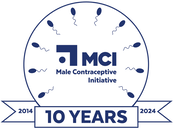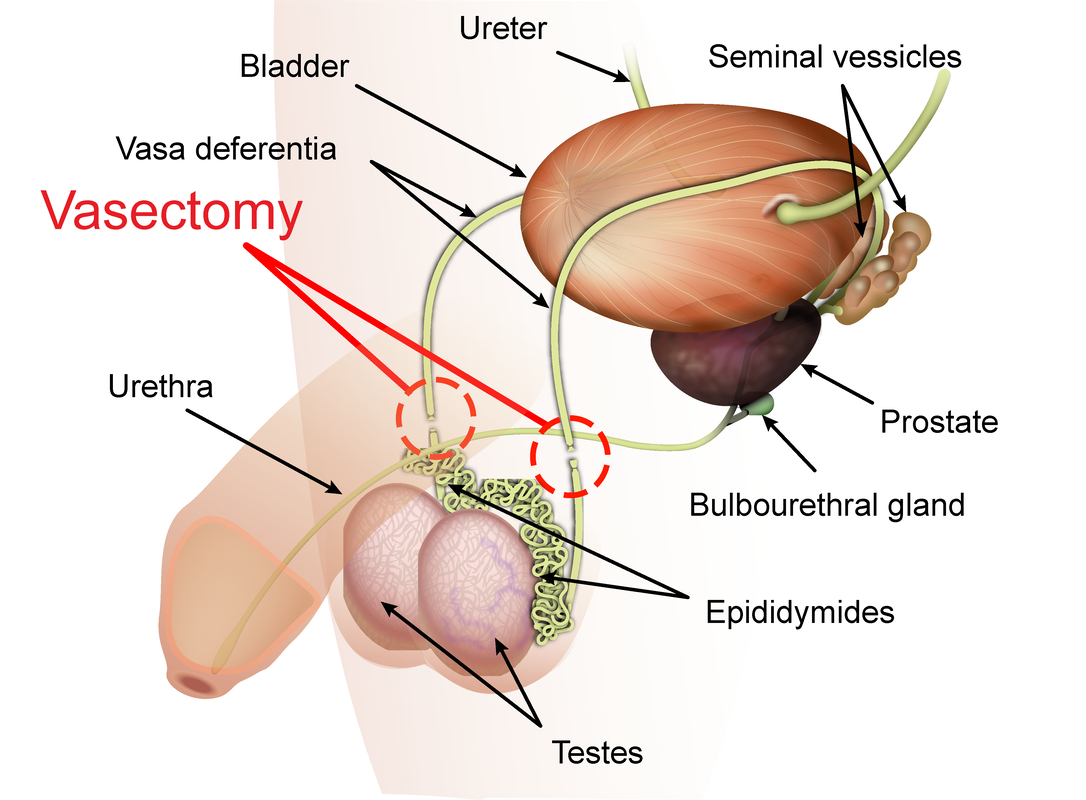|
(Image courtesy of K. D. Schroeder) Vasectomy is a surgical procedure for male contraception. It is intended to be a permanent form of contraception and, along with condoms, is one of the only methods of birth control available for men. During the procedure, the vas deferens in men are cut and tied or sealed in some way (e.g., cauterization) in order to prevent sperm from traveling through the reproductive system and entering into the urethra and, subsequently, prevent fertilization of a female egg through sexual intercourse. For humans, vasectomies are usually performed in a physician's office or medical clinic in an outpatient setting. Hospitalization is not typically required as the procedure is fairly simple, the incisions are small, and the necessary equipment common and readily available. There are different methods for a vasectomy, all of which occlude (i.e., stop, close, or block) at least one side of each vas deferens (note: there is a vas deferens connecting each testicle to the urethra):
A vasectomy is such a simple procedure that it usually takes only mere minutes to complete, and patients are able to go home to rest after a short recovery at the doctor's office. Also, since the procedure is minimally invasive, a majority of people who get a vasectomy can resume their typical sexual behavior within a short period of time (around one week), and do so with little or no discomfort. However, immediately post-procedure, men are still fertile. It can take many weeks for sperm to completely exit the male reproductive tract, and patients undergo regular sperm checks to verify success of the procedure. It is important to note that people who have had a vasectomy can still have and enjoy sexual intercourse as they normally would; the procedure does not affect a man’s sex drive, only his fertility. Again, the procedure is intended to be a permanent method of contraception. Reversibility is possible, but the success rates vary across individuals and decrease dramatically over time. Vasectomy reversal is also a very expensive procedure, which is not as widely available as vasectomy due to the required expertise and equipment. Nuts & Bolts: Vasectomy To learn more about, please visit our series of posts about male reproduction and contraception: Key terms: Cauterization - medical practice or technique of burning a part of a body to remove or close off a part of it. Occlude - stop, close up, or obstruct (an opening, orifice, or passage). Vas deferens - the duct which conveys sperm from the testicle to the urethra. For additional terminology related to male contraception and the male reproductive system, please visit our glossary: Sources/References: Sokal, David; Irsula, Belinda; Hays, Melissa; Chen-Mok, Mario; Barone, Mark A; Investigator Study, Group (2004). "Vasectomy by ligation and excision, with or without fascial interposition: a randomized controlled trial ISRCTN77781689". BMC Medicine. 2 (1): 6. Trussell, James (2011). "Contraceptive efficacy". In Hatcher, Robert A.; Trussell, James; Nelson, Anita L.; Cates, Willard Jr.; Kowal, Deborah; Policar, Michael S. (eds.). Contraceptive technology (20th revised ed.). New York: Ardent Media. pp. 779–863. ISBN 978-1-59708-004-0. ISSN 0091-9721. OCLC 781956734. Nielsen CM, Genster HG (1980). "Male sterilization with vasectomy. The effect of the operation on sex life". Ugeskrift for Lægerer. 142 (10): 641–643. PMID 7368333. Royal College of Obstetricians and Gynaecologists. "Sterilisation for women and men: what you need to know". Archived from the original on 2011-01-04. Schwingl, Pamela J; Guess, Harry A (2000). "Safety and effectiveness of vasectomy". Fertility and Sterility. 73 (5): 923–936. "Vasectomy". University of Miami Health System, Miller School of Medicine. University of Miami Health System, Miller School of Medicine. Retrieved 28 December 2019. Healthwise Staff (May 13, 2010). "Vasectomy Procedure, Effects, Risks, Effectiveness, and More". Webmd.com. Cook, LA; Van Vliet, HA; Lopez, LM; Pun, A; Gallo, MF (30 March 2014). "Vasectomy occlusion techniques for male sterilization". The Cochrane Database of Systematic Reviews (3): CD003991. Cook, Lynley A.; Van Vliet, Huib AAM; Lopez, Laureen M; Pun, Asha; Gallo, Maria F (2014). Cook, Lynley A. (ed.). "Vasectomy occlusion techniques for male sterilization". Cochrane Database of Systematic Reviews (2): CD003991. doi:10.1002/14651858.CD003991.pub4. PMC 7173716. "About Vasectomy Reversal". Professor Earl Owen's homepage. Archived from the original on 2007-12-06. Retrieved 2007-11-29. For additional publications related to male contraception and the male reproductive system, please visit our publications page:
Comments are closed.
|
Categories
All
Archives
June 2024
|
|
|
Donate to Male Contraceptive InitiativeYour generous donation makes a difference!
|
© Male Contraceptive Initiative. All rights reserved.


 RSS Feed
RSS Feed
